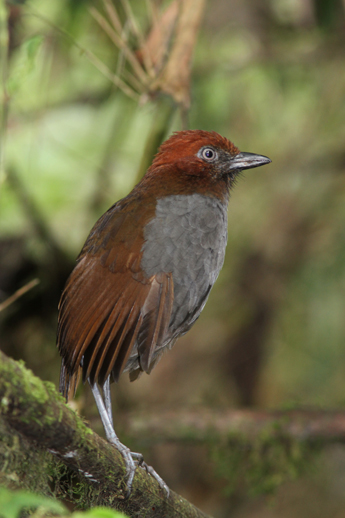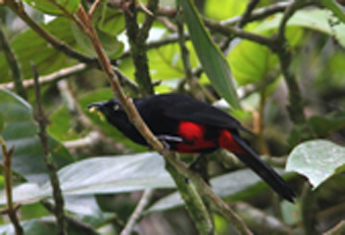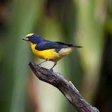Day 1
Arrival in Cali and transfer to our hotel, birding on the way and onsite in the Western Cordillera.
Day2 Finca La Araucana, Bichacue Yath Reserve and Andean-Cock-of-the-rock lek
We will rise early and head to Finca La Araucana, where we will spend the morning birding from the balcony and the sprawling grounds. The feeders at La Araucana offer close-up views of many species, including Green Honeycreeper, Bay-headed Tanager, Flame-rumped Tanager and the near-endemic ScrubTanager. We will feast our eyes and cameras and then take a tour of the property in hopes of running into the very vocal Bar-crested Antshrike and large groups of Spectacled parrotlets. We then head to have lunch at the Bichacue Yath reserve, a beautiful moss and fairy garden that also offers great birding opportunities. The aternoon will be spend on a short hike to the Andean Cock-of-the-rock lek.
Days3-4 El 18 and Bosque de San Antonio
Next morning we will bird nearby, along a jeep track that passes through fragments of cloud forest with good mixed flock activity. Birding here can be very productive and we will search out three endemics, Chestnut Wood-quail, Grayish Piculet and Multicolored Tanager. A paradise for Tanagers, we will also look for Purplish-mantled, Summer, Golden, Scrub, Metallic-green, Saffron-crowned, and Golden-naped Tanagers,as well as Ash-throated Bush-Tanagers and Blue-winged Mountain-Tanager. Other birds we might see in this area include Golden–headed Quetzal, Scarlet-fronted Parakeet, Crimson-rumped Toucanet, Scaled Fruiteater,Green and Black Fruiteater, Chestnut-breasted Wren, Black-billed Peppershrike, Chestnut-breasted and Blue-naped Chlorophonia, Greenish Puffleg, Montane Woodcreeper, Scale-crested Pygmy-tyrant, Redfaced Spinetail, Spotted and Rusty-winged Barbtails, Streaked Xenops and Narino Tapaculo. It will be easy to see the hyperactive Cinnamon Flycatcher, and a delight to listen to Andean Solitaire. An impressive show of hummingbirds and Tanagers can be observed at a private house known as “Raul’s Place”, including the following species: Purple-throated Woodstar, Blue-headed Saphire, Brown Violetear, Green Violetear, Fawn-Breasated Brilliant, Speckled Hummingbird, Wedgebilled Hummingbird, Long-tailed Sylph, White-necked Jacobin and Tawny-bellied Hermit. The night will be spent at Hotel El Faro and the next morning we will bird at the higher elevations of the Bosque de San Antonio. After devoting the morning to the Bosque de San Antonio, we will have lunch at a friend’s house, where the serene environment, great hospitality and impressive feeders mix together for the perfect afternoon. We will then return to El Faro for some rest considering that next day is one of the longest travel days.
Day5 San Cipriano
We will leave the hotel at 4 am for our 2.5-hour drive to Cordoba. From Cordoba we will load up on “brujitas” and have a pleasant 20 minute rail ride to the town of San Cirpiano. The area is a protected reserve and is the source of drinking water for the nearby port city of Buenaventura. Located in the Choco Bioregion, it is known for being one of the wettest places on the planet. Here we will hike several trails were we will come across Chestnut-mandibled Toucans, Strip-billed Aracaris, White-tipped and Blue Cotinga,Rose-faced and Blue-headed Parrots, Spot-crowned Barbet, Black-chested Puffbird, and Purple-throated Fruitcrow. Blue-whiskered, Emerald, Palm, Dusky-faced, Tawny-crested and Rufous-winged Tanager are also possible. We will also have chances for Scarlet-rumped Cacique, Ruffous-tailed Jacamar, Ocellated, Jet, Stub-tailed and Bicolored Antbird, plus Long-tailed Tyrant amongst many others. We can swim and/or float the Rio Escalerete, a refreshing, pristine river. We will return to San Cipriano and head to Buga for the night. Buga is a lovely town with a lot of character and we will be staying in the colonial style Hotel Guadalajara. Those who wish can tour the town or relax at the hotel pool.
Day6 Sonso Lagoon
We will rise early and be at the Sonso Lagoon within ten minutes. The lagoon is one of the only remaining wetlands in the Cauca Valley and one of Colombia’s best wetland birding localities. The wetland is teeming with aquatic birds, so we will search the waters for Wattled Jacana, Anhinga, Little Blue, Cocoi and Striated Herons, Snowy Egret, Bare-faced and Glossy Ibises, Fulvous and Black-bellied Whistling-Ducks, Cinnamon Teal, Osprey, Snail Kite, Black-necked Stilt, Neotropic Cormorant, Lesser and Greater Yellowlegs, and Spotted and Least Sandpipers. Rare species we might come across include Pinnated Bittern, the endemic Apical Flycatcher, Roseate Spoonbill, Ruby Topaz and Horned Screamer. Along riparian areas it is possible we seeSouthern Lapwing, Greater Ani, Ringed Kingfisher, Northern-Crested and Yellow-headed Caracara, Spotbreasted Woodpecker, Southern Beardless and Mouse-coloured Tyrannulets, Yellow Warbler, Yellow-olive Flycatcher, Grey and Ruddy-breasted Seedeaters, Blue-black Grassquit, and Cinereous Becard. At nearby oxbows, locally called madres viejas we will also be able to observe the attractive Jet Antbird, Orange-crowned Euphonia, and Slate-headed Tody-Flycatchers plus the beautiful Fiery Topaz. After a long morning birding temperature gets high, so we will have a break and lunch at a nearby restaurant that has some of the best “sancocho”, typical Colombian soup. We will have the afternoon to enjoy the pool and dine in Buga and in the afternoon we will head out on a 3.5 hour drive to the Otun –Quimbaya Reserve, where we will spend the night.
Days 7-8 Otun Quimbaya
We will rise early in the morning and start birding at the Otun-Quimbaya Reserve, at the doorsteps of our hotel. We will be received by the sounds of howling monkeys and the endangered, endemic Cauca Guan. They are relatively easy to see here, although they were believed to be extinct until a population of the species was rediscovered in 1990. Otun is also one of the best places in the world to observe Red-ruffed Fruitcrow. Birding along a dirt road will be productive in finding forest skulkers such as the endemic Chestnut Wood Quail, Chestnut-breasted Wren, Stile’s Tapaculo, a recently described endemic, Moustached Antpitta and Russet-crowned Warbler. We will also focus attention on the road and adjacent areas, where mixed groups assemble such in a birder’s dream with species like Plumbeous-crowned Tyrannulet, Rufous-breasted Flycatcher, Three-striped Warbler, Canada Warbler. Masked Trogon, Inca Jay, Black-billed Peppershrike, Marble-faced and Variegated Bristle-Tyrants, Highland Motmot, Black-billed Mountain-Toucan, Andean Cock-of-the-rock, Golden-fronted Redstart, Blue-naped Chlorophonia, Orange-bellied Euphonia, and Glossy and Masked Flowerpiercer can be seen here. After a productive day of birding we will return to the lodge for another night. The next morning we will devote to find the famous torrent duck, before having an early lunch and heading to Manizales which is about 3-hour drive. We will stop and bird at a roadside lake where we will be able to add many new birds to our list including Pied Grebe, Masked Duck and Blackish Rail. We will spend the next two nights at the Rio Blanco Reserve, touted as one of the three best birding sites in the world.
Days 9-10 Rio Blanco Reserve
Manizales is in the center of the famed Coffee Triangle, and is a great city from which we can visit several reserves that hold some of Colombia’s rarest and most threatened species. We will be staying at Rio Blanco 2 nights, were the accommodation is rustic but very clean and birding is simply superb. It is possible to observe five species of Antpitta including the endemic Brown-banded, plus Bicolored, Chestnut-crowned, Chestnut-naped and Slate-crowned Antpitta within a few hours at the three feeders located within a short hike from the lodge. The endemic Rufous-fronted Parakeet and the very rare Masked Saltator are usually also observed in the vicinity of the lodge. Along with endemic and rare species, this area boasts many sought after species that include Tyrannine Woodcreeper, Golden-faced Redstart, Dusky Piha, Black-billed and Buff-breasted Mountain-Tanagers, Grass-green and White-capped Tanager, Powerful Woodpecker and the often heard, but hard to see Tapaculos, such as Ocellated, Blakish and Spillman’s Tapaculos. Plushcap, Black-billed Peppershrike, Mountain Cacique and Golden-plumed Parakeet are also can be found. The reserve boasts several well-maintained trails and hummingbird feeders which attract various species including Tourmaline Sunangel, Buff-tailed Coronet, Speckled Hummingbird, Bronzy and Collared Inca, Mountain Velvetbreast, the tiny White-bellied Woodstar and Long-tailed Sylph. After 2 full days of birding at Rio Blanco we will head to Manizales for 2nights at Hotel Termales del Otono, with mineral-rich, medicinal hot-springs and great views of the Central Andes.
Day11 Nevado del Ruiz
Today we will head to the Nevado del Ruiz, following a road through patches of forest that give way to Paramo, a tropical grassland above treeline. The scenery is magical with velvety frailejon plants adding a touch of surrealism. Temperatures will be cold, and we will reach elevations upwards of 13,000 feet. We will seek out high elevation specialists that include: Bearded Helmetcrest, Paramo Tapaculo, Rainbow-bearded Thornbill, Viridian Metaltail, Stout-billed Cinclodes, Brown-backed Chat-Tyrant, Scarlet-bellied Mountain-Tanager, Black-backed Bush-Tanager, Glossy Flowerpiercer and the endemic and very hard to find Rufous-fronted Parakeet. We will search for this endemic along a 2km stretch of the road that passes through elfin forest. Also fun to watch is the Tawny Antpitta, which is very tame in this area. We will also be able to bird near a glacial laguna called Laguna Negra, were it is possible to see Many-striped Canastero, White-tailed Hawk, Black-chested Buzzard-Eagle, Andean Tit-Spinetail, White-chinned Thistletail, Andean Duck, Andean Teal, Grass Wren, and Pale-naped Brush-Finch. A bonus is the variety of seedeaters in the Paramo, including Plumbeous Sierra-Finch, Paramo and Plain-colored Seedeaters. After a day of birding we will head to Termales del Otono for another night.
Day12 Manizales
We will spend the morning birding at Alcazares City Park, which offers amazing birding opportunities within Manizales city limits. Targets here include Red-headed barbet, Flame-rumped Tanager and the endemic Bar-crested Antshrike. Other birds we might encounter include Bay-breasted Tanager, Emerald Toucanet, Golden-olive Woodpecker, Golden-faced Tyrannulet, Yellow-bellied Siskin and Streaked Saltator. For lunch we will have Ajiaco, a typical Colombian soup made with potatoes and chicken and garnished withcapers and cream…..deeeelicious. We will head on a 4 hour drive back to Cali, where we will spend the night in Hotel Casa Alferez, located in the trendiest and exclusive sector of Cali. We will have dinner and drinks at a nearby restaurant to recap on the good times we had during the trip.
Day13 Day in Cali and suburbs
We will have a morning tour with the Dolmetsch Arboretum’s director, Alvaro Calonje followed by a lunch. The arboretum is one of the largest in Colombia and boasts a collection of 2200 species of plants from around the world. It also offers great birding opportunities. We will spend the night at Hotel Casa Alferez in the plushest area of Cali.
Day14 Depart Cali
Transfer to the airport from Hotel Casa Alferez to catch flights.
Day15 Arrival home after an overnight flight
Extension possibility
6days/5nights extension possibility at the World-famous Santa Marta mountains, Minca & El Dorado, a real heaven for endemics.
































